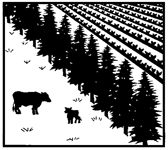U.S. Department of Agriculture: Forest Service -- National Agroforestry Center
Date of this Version
8-1-1996
Abstract
In April of 1987, a spring blizzard swept through northern Kansas and southern Nebraska killing nearly 60,000 newborn calves and other winter stressed animals. This tremendous loss could have been lessened had protection, such as outdoor living barns (OLB), been provided to reduce the windchill. An outdoor living barn is a specialized windbreak, typically composed of trees and shrubs, and strategically located in open grasslands, center pivot irrigation corners, and pasture areas to protect livestock during severe weather situations.
The purpose of an OLB is to: 1) defuse and deflect cold winds away from livestock, moderating the windchill; and 2) trap and hold blowing snow, preventing it from covering feed, water, and livestock. Outdoor living barns pay for themselves by cutting livestock losses, lowering feed costs, and sustaining animal health during stressful weather conditions.


Comments
Published by National Agroforestry Center, USDA Forest Service, Rocky Mountain Station, USDA Natural Resources Conservation Service, East Campus – UNL, Lincoln, Nebraska 68583-0822.